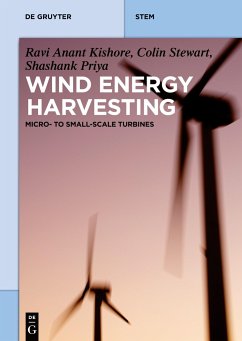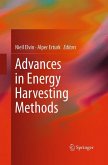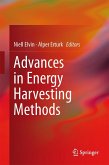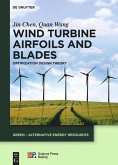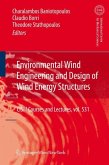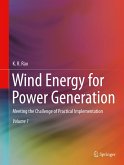•Includes fundamental concepts required for designing small scale wind turbines.
•Wind turbine aerodynamic behavior, application requirements, fabrication techniques and other key factors are included.
•Several solved numerical problems have been included.
Wind Energy: Micro- to Small-Scale Turbines provide fundamental design concepts required for development of both micro- and small scale wind turbines at low speed applications. Basic design techniques are covered, as well as various fabrication techniques that can be used to manufacture cost-effective and efficient small scale wind turbines. Coverage of aspects related to materials science and engineering, as well as mechanical engineering, is included. Each chapter has solved numerical problems which are used as examples. Additional unsolved problems are provided at the end of each chapter. The book is suitable for courses on energy harvesting, sustainable energy and fluid dynamics, as well as for more focused courses on wind energy harvesting.
This book provides the fundamental concepts required for the development of an efficient small-scale wind turbine. For centuries, engineers and scientists have used wind turbines of all shapes and sizes to harvest wind energy. Large-scale wind turbines have been successful at producing great amounts of power when deployed in sites with vast, open space, such as in fi elds or in offshore waters. For environments with limited space, such as dense urban environments, small-scale wind turbines are an attractive alternative for taking advantage of the ubiquity of wind. However, many of today's tools for aerodynamic design and analysis were originally developed for large-scale turbines and do not scale down to these smaller devices. Arranged in a systematic and comprehensive manner, complete with supporting examples, Wind Energy Harvesting: Micro- To Small-Scale Turbines is a useful reference for undergraduate and graduate level classes on energy harvesting, sustainable energy, andfl uid dynamics, and an introduction to the field for non-technical readers.
•Wind turbine aerodynamic behavior, application requirements, fabrication techniques and other key factors are included.
•Several solved numerical problems have been included.
Wind Energy: Micro- to Small-Scale Turbines provide fundamental design concepts required for development of both micro- and small scale wind turbines at low speed applications. Basic design techniques are covered, as well as various fabrication techniques that can be used to manufacture cost-effective and efficient small scale wind turbines. Coverage of aspects related to materials science and engineering, as well as mechanical engineering, is included. Each chapter has solved numerical problems which are used as examples. Additional unsolved problems are provided at the end of each chapter. The book is suitable for courses on energy harvesting, sustainable energy and fluid dynamics, as well as for more focused courses on wind energy harvesting.
This book provides the fundamental concepts required for the development of an efficient small-scale wind turbine. For centuries, engineers and scientists have used wind turbines of all shapes and sizes to harvest wind energy. Large-scale wind turbines have been successful at producing great amounts of power when deployed in sites with vast, open space, such as in fi elds or in offshore waters. For environments with limited space, such as dense urban environments, small-scale wind turbines are an attractive alternative for taking advantage of the ubiquity of wind. However, many of today's tools for aerodynamic design and analysis were originally developed for large-scale turbines and do not scale down to these smaller devices. Arranged in a systematic and comprehensive manner, complete with supporting examples, Wind Energy Harvesting: Micro- To Small-Scale Turbines is a useful reference for undergraduate and graduate level classes on energy harvesting, sustainable energy, andfl uid dynamics, and an introduction to the field for non-technical readers.

